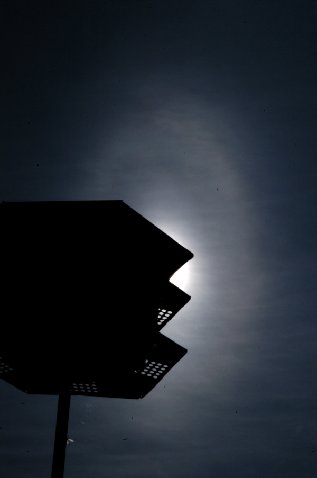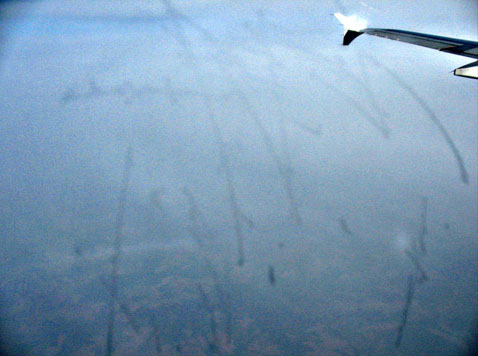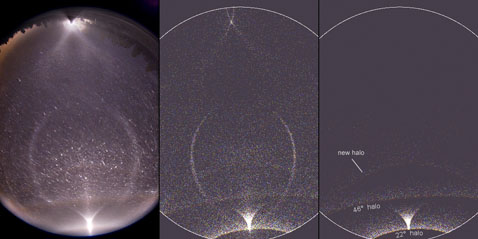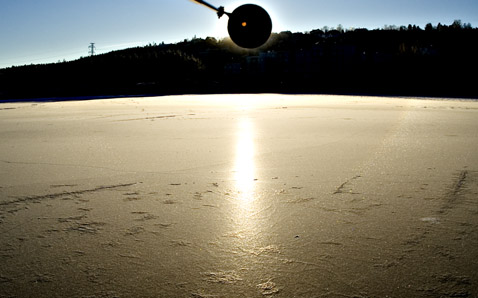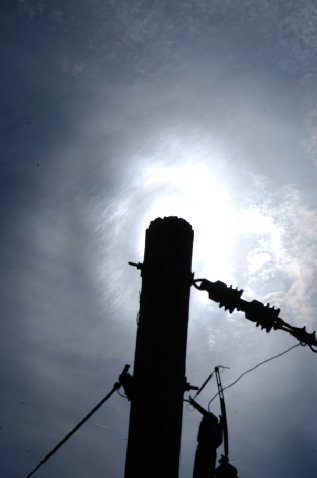While staying with relatives down in Bedford Indiana, one morning before we left to French Lick Casino I saw a large field of AC clouds slowly moving out of the area and I know AC clouds means elliptical halos. I looked up and saw the trailing edge of the clouds nearing the sun and I noticed they were forming virga sheets and as it drew nearer I took the gamble to watch. As the sun came into view I saw a diffuse sunpillar form and it later on got more defined and I watched as a small crescent of light formed in the pillar and it coalesed into an elliptical halo! Throughout the duration I could only see one ellipse and it was quite bright and well defined. I only need two more to tie Mika Sillanpaa's record. Look out Mika I need two more observations to tie your record and who knows I could beat it. I will gamble with halos not at slot machines at least I won't loose money with halos. ( 1 ).
Text: Michael Ellestad
Tuesday, 20 October 2009
Monday, 19 October 2009
Sub-120° parhelion photographed
Starting from the 1970's we have seen numerous photos of subparhelic circle opposite to the sun and it is a little wonder that sub-120° parhelion has never been observed from an airplane. Even the sub-Liljequist parhelion, of which formation is sensitive to crystal shape deviations from regular hexagon, and which from that point of view should be rarer than sub-120° parhelion, has been photographed a couple of times.
Well, given enough time, things are bound to change. On 31 July this year sub-120° parhelion was finally photographed. The man behind the camera, Tomas Trzicky, was on a return trip from watching a total sun eclipse in China. The halo display appeared on the last stretch of this trip, on its last hour, when the airplane started descending to Prague.
"I was really lucky - actually I was sitting in the isle during most of the flight, one member of our observing group left her window seat for a while, so I more or less routinely checked the white haze outside - and there it was :-)", tells Tomas.
The sub-120° parhelion was captured on two photos, click on the image above to see them. To the left from the halo is a patch of subparhelic circle, which most probably is sub-Liljequist parhelion. Further left, in other photos, subanthelion and faint diffuse anthelic arcs crossing it are also visible ( 1 ). The window was dirty and it was frosty, but it just adds to the magic of discovery.
These photos may explain why sub-120° parhelion has not been captured earlier. It occurs as an isolated white spot, without subparhelic circle crossing it. Unless being exceedingly bright, it must be easily missed. Most certainly sub-120° parhelion has occurred in all of the displays with subparhelic circle, because plates are the major contributor to subparhelic circle intensity. Subparhelic circle made solely by Parry orientation is more of a theoretical consideration, and columns do not make subparhelic circle at all.
Sub-120° parhelion has been photographed once earlier in spotlight beam in diamond dust ( 2 ), but Tomas's "old school" observation is of course the true discovery. See also Les Cowley's report ( 3 ) on the case.
Sunday, 18 October 2009
New halo from spotlight beam
It's been before our noses for a year already ( 1 ): the weak colored arc reaching far outside the 46° halo in the display observed on the night of 5/6 November 2008 in Rovaniemi. I have thought of it as some sort of 46° supralateral arc extension below the horizon. But something has not felt quite right with that and I finally decided to run a simulation.
The halo arises in column crystals from 3-5-1 and 3-6-1 raypaths ( 2 ). Thus it is not 46° supralateral arc. Rather, these raypaths make it a reflection of 46° supralateral arc. If circumnadir arc had been visible in the display, this halo would have been tangent to it ( 3 ) similarly as normal 46° supralateral arc is tangent to circumzenith arc.
The simulation above was made with column and random oriented crystals. Crystals towards triangular shape seemed to provide best overall fit with the photo. Light source elevation for the simulation was -11.5 degrees. The simulation on the right is filtered, showing some common halos together with the new halo arc.
What should we call this? Reflected (46°) supralateral arc or sub(-46°) supralateral arc? If we were to choose the former, the "Ounasvaara arc" ( 4 ) which arises from similar raypath (8-4-1) in Parry crystals, could be then called reflected (46°) Parry supralateral arc.
Simulations and crystal raypath figures are from Jukka Ruoskanen's software.
Blue circle and blue spot
These simulations show the relation of blue circle (from random crystals) and blue spot (from oriented crystals). Blue spot on parhelic circle occurs where blue circle crosses it. The blue circle itself has a radius of 64°, as Ágnes Kiricsi has pointed out, and it is centered around the subanthelic point. Sun elevations in the simulations are 10°, 20° and 31°. When sun is higher than 32°, blue spot is no more seen. Simulations are made with Jukka Ruoskanen's software.
Thursday, 8 October 2009
Asymmetric intensity of 22° halo on ice surface
This 22° halo on ice surface was seen on 17 January in Tampere. It was more pronounced on the right side. Intensity asymmetry was not caused by local changes in crystal densities because it was seen wherever I walked on the ice.
The effect must be made by atsimuthally oriented crystals on the lake ice. Possibly wind blowing from one direction had caused non-uniform deposition of moisture, resulting in (poorly) atsimuthally locked crystals.
See animation ( 1 ), which involves about 70 photos taken during 30 meters camera movement. The asymmetry effect is also seen in stacked image of 117 frames ( 2 )
This is not the first time when asymmetry of halos on ice surface has been noticed. In December 2007 Jari Piikki photographed curiously inclined halos in Juva ( 3 ).
Monday, 5 October 2009
Elliptical halos from the US
On 1 October I got two elliptical halos and you can see them here. I would have gotten more pics but I was busy helping my mother get the house ready for the fall harvest party. I wish I could have seen the halos from the start but when I first saw it the halos were in progress. This will count as my third elliptical halo observation this year ( 1 ).
Text: Michael Ellestad
Text: Michael Ellestad
